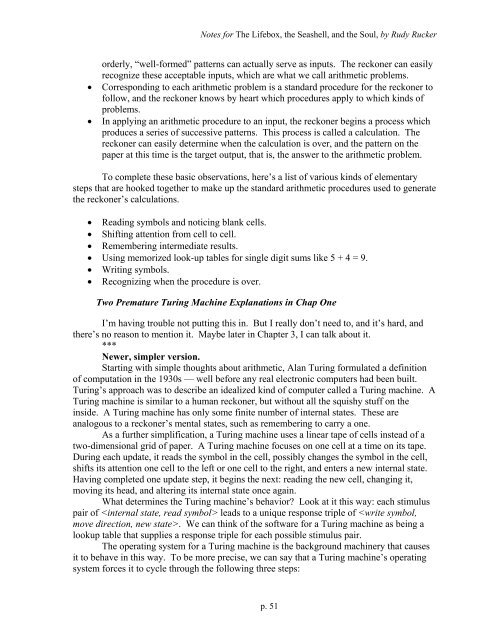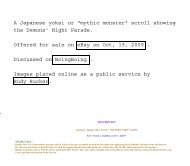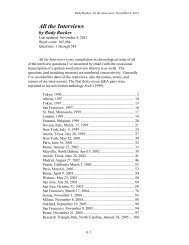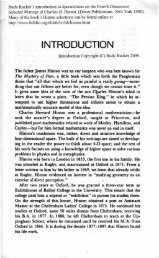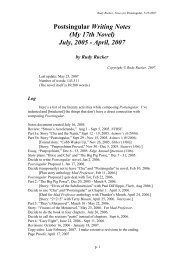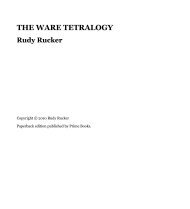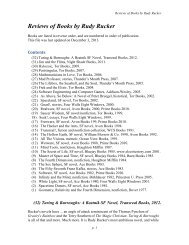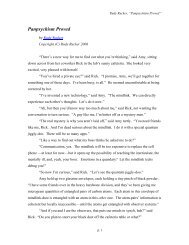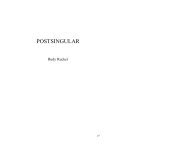Notes for the Lifebox, the Seashell, and the Soul - Rudy Rucker
Notes for the Lifebox, the Seashell, and the Soul - Rudy Rucker
Notes for the Lifebox, the Seashell, and the Soul - Rudy Rucker
Create successful ePaper yourself
Turn your PDF publications into a flip-book with our unique Google optimized e-Paper software.
<strong>Notes</strong> <strong>for</strong> The <strong>Lifebox</strong>, <strong>the</strong> <strong>Seashell</strong>, <strong>and</strong> <strong>the</strong> <strong>Soul</strong>, by <strong>Rudy</strong> <strong>Rucker</strong><br />
orderly, “well-<strong>for</strong>med” patterns can actually serve as inputs. The reckoner can easily<br />
recognize <strong>the</strong>se acceptable inputs, which are what we call arithmetic problems.<br />
• Corresponding to each arithmetic problem is a st<strong>and</strong>ard procedure <strong>for</strong> <strong>the</strong> reckoner to<br />
follow, <strong>and</strong> <strong>the</strong> reckoner knows by heart which procedures apply to which kinds of<br />
problems.<br />
• In applying an arithmetic procedure to an input, <strong>the</strong> reckoner begins a process which<br />
produces a series of successive patterns. This process is called a calculation. The<br />
reckoner can easily determine when <strong>the</strong> calculation is over, <strong>and</strong> <strong>the</strong> pattern on <strong>the</strong><br />
paper at this time is <strong>the</strong> target output, that is, <strong>the</strong> answer to <strong>the</strong> arithmetic problem.<br />
To complete <strong>the</strong>se basic observations, here’s a list of various kinds of elementary<br />
steps that are hooked toge<strong>the</strong>r to make up <strong>the</strong> st<strong>and</strong>ard arithmetic procedures used to generate<br />
<strong>the</strong> reckoner’s calculations.<br />
• Reading symbols <strong>and</strong> noticing blank cells.<br />
• Shifting attention from cell to cell.<br />
• Remembering intermediate results.<br />
• Using memorized look-up tables <strong>for</strong> single digit sums like 5 + 4 = 9.<br />
• Writing symbols.<br />
• Recognizing when <strong>the</strong> procedure is over.<br />
Two Premature Turing Machine Explanations in Chap One<br />
I’m having trouble not putting this in. But I really don’t need to, <strong>and</strong> it’s hard, <strong>and</strong><br />
<strong>the</strong>re’s no reason to mention it. Maybe later in Chapter 3, I can talk about it.<br />
***<br />
Newer, simpler version.<br />
Starting with simple thoughts about arithmetic, Alan Turing <strong>for</strong>mulated a definition<br />
of computation in <strong>the</strong> 1930s — well be<strong>for</strong>e any real electronic computers had been built.<br />
Turing’s approach was to describe an idealized kind of computer called a Turing machine. A<br />
Turing machine is similar to a human reckoner, but without all <strong>the</strong> squishy stuff on <strong>the</strong><br />
inside. A Turing machine has only some finite number of internal states. These are<br />
analogous to a reckoner’s mental states, such as remembering to carry a one.<br />
As a fur<strong>the</strong>r simplification, a Turing machine uses a linear tape of cells instead of a<br />
two-dimensional grid of paper. A Turing machine focuses on one cell at a time on its tape.<br />
During each update, it reads <strong>the</strong> symbol in <strong>the</strong> cell, possibly changes <strong>the</strong> symbol in <strong>the</strong> cell,<br />
shifts its attention one cell to <strong>the</strong> left or one cell to <strong>the</strong> right, <strong>and</strong> enters a new internal state.<br />
Having completed one update step, it begins <strong>the</strong> next: reading <strong>the</strong> new cell, changing it,<br />
moving its head, <strong>and</strong> altering its internal state once again.<br />
What determines <strong>the</strong> Turing machine’s behavior? Look at it this way: each stimulus<br />
pair of leads to a unique response triple of . We can think of <strong>the</strong> software <strong>for</strong> a Turing machine as being a<br />
lookup table that supplies a response triple <strong>for</strong> each possible stimulus pair.<br />
The operating system <strong>for</strong> a Turing machine is <strong>the</strong> background machinery that causes<br />
it to behave in this way. To be more precise, we can say that a Turing machine’s operating<br />
system <strong>for</strong>ces it to cycle through <strong>the</strong> following three steps:<br />
p. 51


